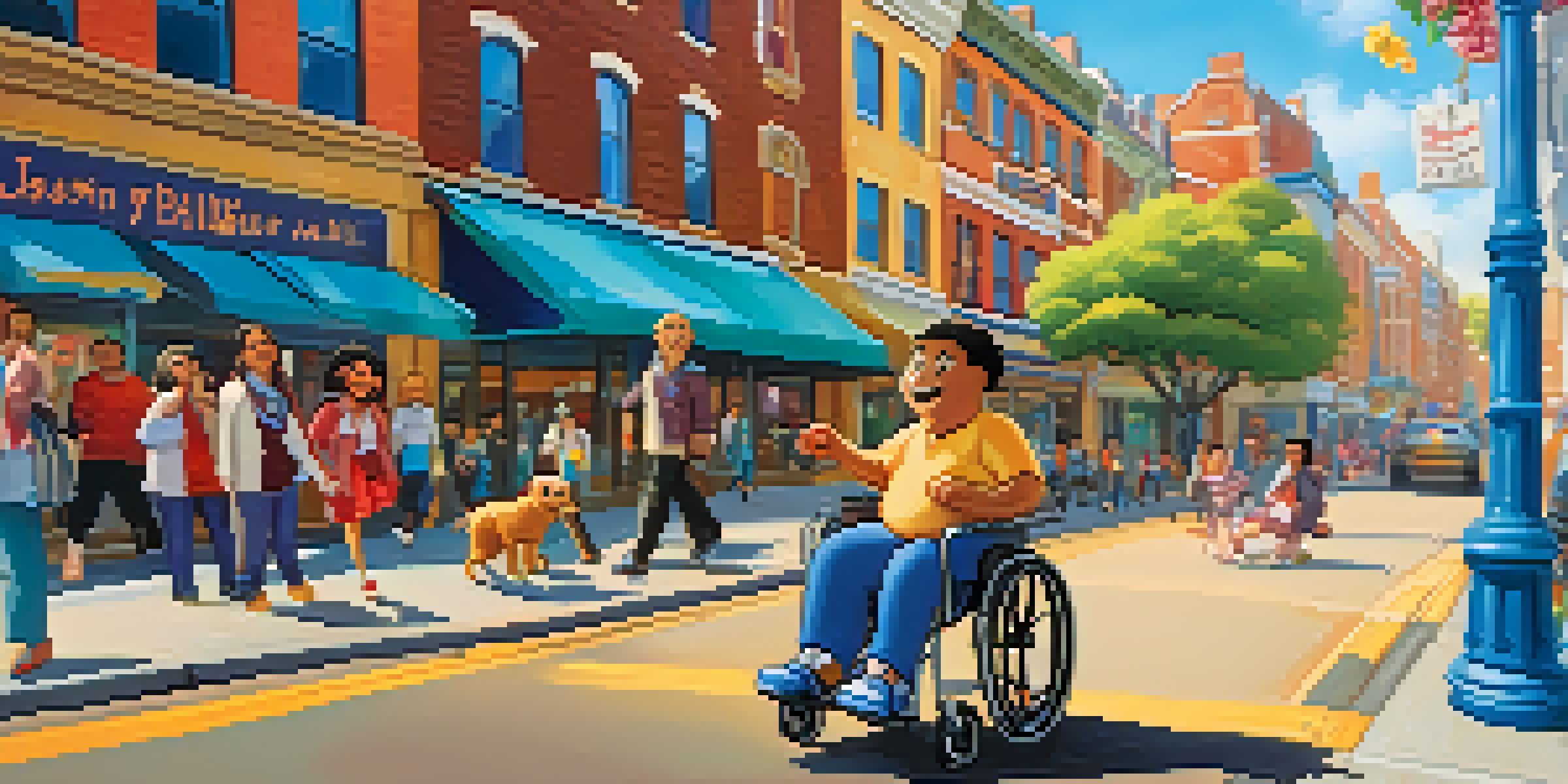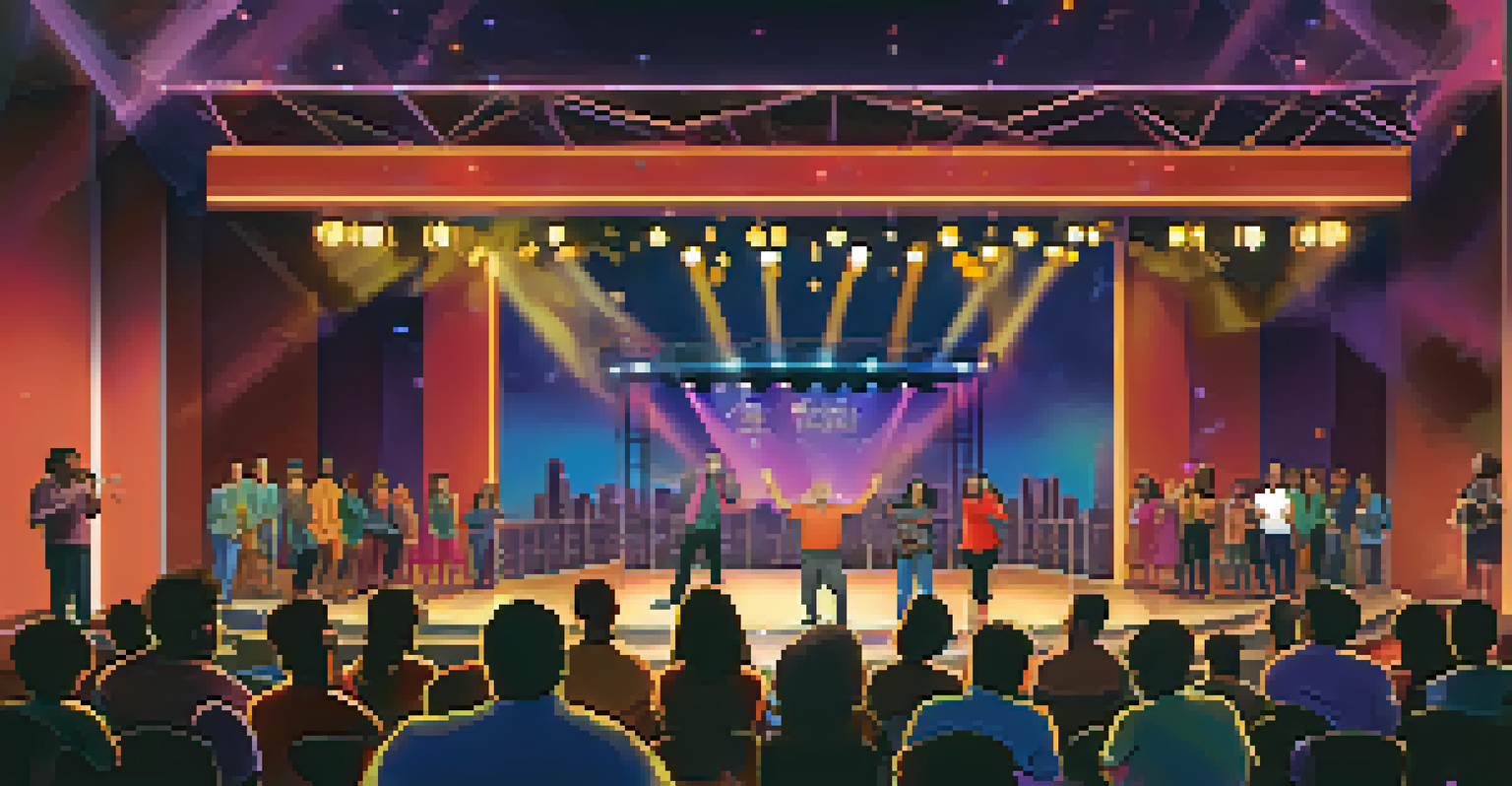Disability and Humor: Representation in Satirical Art

Understanding Satirical Art and Its Purpose
Satirical art has long been a powerful medium for social commentary, using humor to highlight societal issues. This form of art often employs exaggeration and irony to provoke thought and spark conversations. By making us laugh, satirical artists can address uncomfortable topics, including disability, in a way that feels approachable and engaging.
Satire is a sort of glass, wherein beholders do generally discover everybody's face but their own.
Through satire, artists can challenge stereotypes and misconceptions surrounding disability. For instance, a cartoon might depict a character with a disability navigating everyday life, shedding light on both the struggles and triumphs they face. This not only entertains but also invites viewers to empathize with those experiences, fostering a deeper understanding.
Ultimately, the goal of satirical art is to encourage reflection and dialogue. By blending humor with critical perspectives, these artists create a space where audiences can confront their biases and learn more about the realities of living with a disability.
The Impact of Humor on Perceptions of Disability
Humor can be a double-edged sword when it comes to disability; it can either reinforce negative stereotypes or help dismantle them. When done thoughtfully, humor can create a safe space for discussion, allowing individuals to laugh at the absurdities of life rather than feel burdened by them. This approach can empower both the artist and the audience, transforming perspectives on disability.

For example, comedians with disabilities often share their personal experiences through a humorous lens, making their stories relatable and engaging. By laughing about challenges, they not only validate their experiences but also encourage others to see the lighter side of life. This shift in perspective can significantly alter societal views on disability.
Satirical Art Sparks Dialogue
Satirical art uses humor to provoke thought and foster conversations about societal issues, including disability.
Moreover, humor can act as a bridge between different communities, fostering understanding and connection. When people laugh together, it can break down barriers, allowing for conversations that might not otherwise occur. This is particularly relevant in discussions about disability, where shared laughter can promote inclusivity.
Satirical Representations: The Good, the Bad, and the Ugly
Not all representations of disability in satirical art are created equal. While some artists successfully use humor to challenge stereotypes, others may inadvertently perpetuate harmful narratives. It's crucial to analyze the intent and impact behind these representations, as they can shape public perception in profound ways.
The function of satire is to show the world what it ought to be.
For instance, satirical pieces that rely on outdated stereotypes can reinforce stigma and exclusion. A cartoon that mocks a person with a disability might elicit laughter, but it can also perpetuate negative attitudes and discrimination. Therefore, it's essential for artists to be mindful of the messages they convey through their work.
On the flip side, satirical art that highlights the absurdity of societal attitudes toward disability can be incredibly powerful. By turning the lens on those who perpetuate stereotypes, artists can encourage audiences to question their own beliefs and biases. This kind of representation not only entertains but also educates, making it a valuable tool for change.
Famous Satirical Artists and Their Contributions
Throughout history, several artists have made significant contributions to the representation of disability in satirical art. One notable example is cartoonist Ann Telnaes, whose work often addresses political and social issues, including disability rights. Her ability to blend humor with poignant commentary has sparked important conversations about representation.
Another influential figure is comedian Hannah Gadsby, whose stand-up routines challenge societal norms surrounding disability and mental health. By sharing her personal experiences with humor, she creates a relatable narrative that resonates with many. Gadsby's work underscores the power of humor in fostering understanding and acceptance.
Humor Can Transform Perspectives
When approached thoughtfully, humor in disability discussions can empower individuals and challenge negative stereotypes.
These artists demonstrate that satirical art can be a force for good, using humor to uplift and educate. Their contributions remind us of the importance of representation and the role it plays in shaping our societal views on disability.
Navigating the Fine Line: Sensitivity in Satire
While humor can be a powerful tool for addressing disability, it also requires a delicate balance of sensitivity and awareness. Artists must be conscious of the potential impact their work can have on marginalized communities. Striking the right balance ensures that humor uplifts rather than alienates.
For example, when creating satirical content about disability, artists should consider their audience and the nuances of the topic. It's essential to avoid jokes that reinforce negative stereotypes or trivialize real struggles. Instead, humor should come from a place of empathy and understanding, fostering connection rather than division.
Navigating this line can be challenging, but artists who prioritize authenticity and inclusivity in their work can create lasting impact. By engaging with the disability community and listening to their perspectives, satirical artists can craft humor that resonates positively while still addressing important issues.
The Role of Audience in Satirical Disability Art
The audience plays a crucial role in interpreting satirical art about disability. Viewers bring their own experiences, biases, and perspectives to the table, which can significantly shape how they perceive the humor. This interaction highlights the importance of context in understanding satirical representations.
For instance, someone who has lived experience with disability may find certain jokes empowering, while others may see them as offensive. This divergence emphasizes the need for artists to consider their audience thoughtfully and to be open to feedback. Engaging with diverse perspectives can enhance the effectiveness of their message.
Importance of Sensitivity in Satire
Artists must balance humor with sensitivity to avoid reinforcing harmful stereotypes while promoting inclusivity.
Ultimately, fostering a dialogue between artists and audiences can lead to a richer understanding of disability representation in satire. By encouraging open conversations, both parties can learn from each other, leading to more nuanced and impactful art.
Future Directions: Evolving Representation in Satirical Art
As society continues to evolve, so too does the landscape of satirical art and its representation of disability. Emerging artists are increasingly prioritizing authentic voices and experiences, moving away from outdated stereotypes. This shift is crucial for creating a more inclusive and accurate portrayal of disability in the art world.
Moreover, the rise of digital platforms allows for a greater diversity of voices to be heard. Artists with disabilities are finding new ways to share their stories and perspectives, often using humor as a tool for connection. This democratization of art enables a broader range of experiences to be represented and celebrated.

As we look to the future, it's essential to support and amplify these voices within the satirical art community. By doing so, we can create a more inclusive environment that not only entertains but also educates and inspires positive change in how disability is perceived and represented.